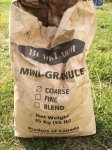Google "Bio-char"
Charcoal has long been used as a soil additive. I've seen photos from Japan, I believe on either Peter Tea's blog or Bjorn Bjornholm's blog or both of trees in Japan, in several well known master's gardens with chunks of charcoal as part of the mix. It is not a "fertilizer" or "nutrient" per se but it does help create a healthy soil environment. As mentioned in the Science Friday podcast, it provides good habitat for soil microbiota including mycorrhiza. It also has CEC capacity, holding nutrients that will be released later when soil moisture nutrient concentration is low. The list of benefits are long, but they are not dramatic or "miraculous". Using charcoal won't necessarily make obvious improvements in tree's health at least initially. But over the long run, you may find trees more resilient.
Also the podcast does suggest a "dose rate" that I've heard before, up to about 5%. In my epiphyte mixes for orchids I use up to about 20% coarse charcoal, the chunks are about 3/8 inch. I have attempted using 100% charcoal as an orchid media, and that was not good, too much a good thing is bad.

Accidentally I've had tree seed germinate in my orchid media and the roots of the tree seedlings adhere to the charcoal bits quite nicely. So a 20% charcoal mix with fir bark and perlite works fine for Norway maple seedlings, and buckthorn seedlings. But buckthorn could grow in old tires for that matter. But it is clear somewhere around 5 % to as much as 20% will be tolerated or enjoyed by most trees, I think the suggested 5% might be a good start for a bonsai mix. Problem would be sourcing charcoal (or bio-char) that is in the same particle size range as the other components of your potting mix would be the most important factor in choosing a source. Particles that are finer than your other components will reduce air voids in your mix, and particles larger than the average for your mix will "float" up in your mix, putting them on the surface where they don't benefit the roots much at all.
When I sift my horticultural charcoal (#3 size in 50 pound bags) I save the fines, sift them again to retain the ones that are between 1/8 and 1/4 inch and blend them into my bonsai mixes. I seldom get enough to use at more than a couple percent, I need to repot my orchids more frequently to have more charcoal for the bonsai. So while I use it, I might not be using it at an effective rate. I used to get #4 size hort charcoal, which was 1/8th to 1/4 inch, a good match for my bonsai mix, but my orchid supplies vendor stopped carrying that size.
Charcoal, hardwood charcoal for backyard cooking, horticultural charcoal, & bio-char are all pretty much just charcoal, except charcoal briquettes which are coal dust that has been compacted & "glued" and formed into the pillow shapes you see in the bag of briquettes. Charcoal should still show signs of the wood grain of the wood it was made from. Coal, while it is plant based carbon, has lost the fine cellular structure of wood and is not useful for horticulture purposes. Bio-char is often made by a less precise (hence cheaper) process, and often will have chunks that still have some wood left, where the carbonization process was not completed. In terms of supporting soil microbiota this is actually a good thing. Many bonsai mixes contain fir bark - this is basically "wood", if your biochar has enough of a woody component you can skip the fir bark in your mix and up the biochar content to cover the percentage of both the charcoal and fir bark components.
I've now shared most the "practical" knowledge I have about biochar, and charcoal. I have a few details in reserve, none of it useful knowledge.

.


